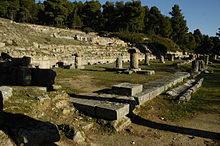Stoa: Difference between revisions
Remove weird POV Tag: references removed |
|||
| Line 20: | Line 20: | ||
==See also== |
==See also== |
||
*[[Agora]] |
|||
*[[Arcade (architecture)]] |
*[[Arcade (architecture)]] |
||
Revision as of 14:31, 30 December 2020

A stoa (/ˈstoʊə/; plural, stoas,[1] stoai,[1] or stoae /ˈstoʊ.iː/[2]), in ancient Greek architecture, is a covered walkway or portico, commonly for public use. Early stoas were open at the entrance with columns, usually of the Doric order, lining the side of the building; they created a safe, enveloping, protective atmosphere.
Later examples were built as two stories, and incorporated inner colonnades usually in the Ionic style, where shops or sometimes offices were located. These buildings were open to the public; merchants could sell their goods, artists could display their artwork, and religious gatherings could take place. Stoas usually surrounded the marketplaces or agora of large cities and were used as a framing device.[3]
Other examples were designed to create safe, protective atmospheres which combined useful inside and outside space. The name of the Stoic school of philosophy derives from "stoa".
Famous stoas

- Stoa Poikile, "Painted Porch", from which the philosophy Stoicism takes its name
- Stoa of Attalos
- Stoa Basileios (Royal Stoa)
- Stoa of Zeus at Athens
- Stoa Amphiaraion
- Stoa of the Athenians
- Royal Stoa of Herod's Temple
See also
References
External links
- YASOU
- . Encyclopædia Britannica (11th ed.). 1911.
